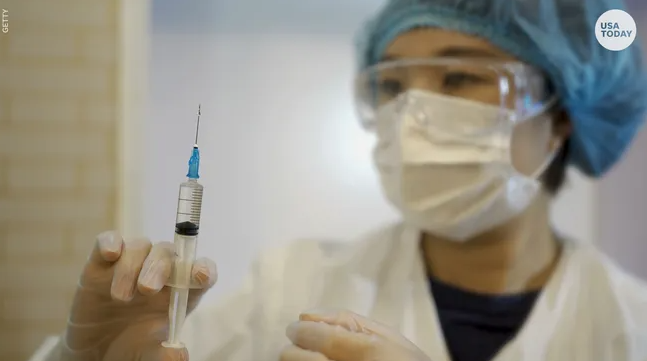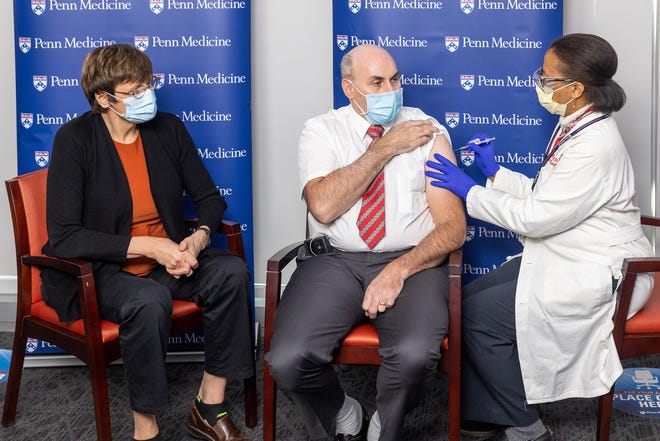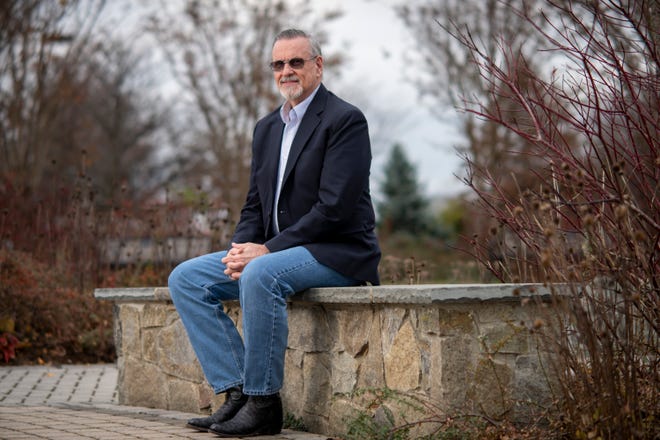
Drew Weissman realized a year ago that even if the COVID-19 vaccines then in progress were eventually approved, it might not be enough. The world might need a next-generation vaccine to rid itself of this pandemic.
Recent outbreaks of more resilient variants suggest he could be right. And yet, when Weissman – discoverer of the mRNA science behind two of the current vaccines – and a team of fellow scientists took a proposal for a more versatile coronavirus vaccine to the National Institutes of Health for funding last May, they left empty-handed.
The group had proposed research on vaccines to protect against any variant of the virus, known as a universal or pan vaccine.
Weissman doesn’t blame NIH staff for the denial; the agency turns down about 80% of its grant applications. Weissman said staff initially wanted to put the grant on a fast-track for approval in September, less than half the time it normally takes. Then, Weissman says, their hands were tied by negative scores from the independent scientists asked to review the grant proposal.
Some of the reviewers, according to Weissman, “said, ‘We don't need a pan coronavirus vaccine,’ which is crazy.”
The NIH says it doesn’t comment on grant applications, and Weissman said the written reviews, as well as the grant application and amount requested, are confidential.
Weissman, however, has some particularly impressive credentials with respect to coronavirus vaccines. He’s one of two scientists at the University of Pennsylvania behind the scientific breakthrough that enabled Moderna and Pfizer to make mRNA vaccines. He also was a consultant to Pfizer on its vaccine.
The NIH grant would have allowed his group to dive into a new approach to vaccinating against coronaviruses, one that would go beyond replicating spike proteins on the virus – the way current vaccines generate antibodies.
In the short run, that could lead to a vaccine to protect against COVID-19 variants not yet discovered. Eventually it also could lead to a vaccine to protect against future coronavirus outbreaks if other strains leap from bats to humans.
Dr. Barton Haynes, director of the Duke Human Vaccine Institute and lead investigator behind the NIH proposal, said another problem the independent reviewers pointed out was a lack of data to show that such a vaccine was possible.
Peer reviews are intended to ensure that the science is rigorous and done anonymously to avoid potential pressure from applicants. The NIH selects individual scientists with expertise to score each application and cannot fund a project with a low score.
Despite the rejection, work did not stop. The scientists managed to rely on private funding to test a vaccine in mice that protects against various strains of coronavirus. Weissman dipped into his own pocket, using money from his mRNA discovery to finance his own research. The team resubmitted its grant request in January.
“The lack of funding certainly slowed the research down,” Weissman said, adding that the money the team could find was “nowhere near the amount of studies that would be done with grant funding.”

The need for a universal vaccine comes down to a matter of survival of the fittest. A virus can change anytime it infects someone new, and the changes most likely to survive and spread are those most resistant to existing immune responses. That means people who have had the disease could get it again, and even those who have been vaccinated could still contract COVID-19.
New variants already have proven more elusive to vaccines. South Africa halted the use of AstraZeneca’s vaccine because of evidence that it wasn’t protecting against mild and moderate cases of the variant most prevalent there. That variant, 50% more contagious, has now reached the United States.
Johnson & Johnson’s vaccine also was less effective against the South African variant, known as B.1.351. The drug company announced last month that during a clinical trial, while its vaccine was 72% effective against moderate to severe COVID-19 in the United States, it was 57% effective in South Africa.
But Johnson & Johnson, which has asked the FDA to allow its vaccine to go on the market later this month, says the good news is that the data found the vaccine to be 85% effective against severe disease even in South Africa. No one who got the vaccine in clinical trials died of COVID-19.
For the vaccine companies, the race is on to do something now, well before a pan-vaccine will be ready. Pfizer and Moderna plan to respond with updated booster vaccines to target the new variants.
Larry Corey, a virologist and co-leader of Operation Warp Speed’s vaccine testing program, said it makes sense to go down both paths – boosters for now and a universal vaccine later. He also warned against assuming that the existing vaccines won’t work.
“For what we wanted, which is to keep you from dying and keep you from getting hospitalized,” he said, “we think the current generation of vaccines will be quite good.”
Michael Osterholm, who served on President Joe Biden’s coronavirus transition team, said the problem with boosters is people will have to constantly get another shot as the virus continues to mutate. Even worse, the longer the virus spreads, the more likely it will develop variants that evade even those protections.
“The vaccines that we have right now have been a very important weapon against this virus. But we’re already realizing the limitations that they have,” Osterholm said. “One of the things we need at a global level is really a creative imagination as to what a second or third generation might look like.”
Q&A:What are all the new COVID-19 variants and how dangerous are they?
Osterholm has warned that even in the short run, the UK variant B.1.1.7 is likely to spread rapidly in the United States.
“In the next six to 12 weeks, B.1.1.7 is going to potentially cause the darkest days of the pandemic in North America,” he said.
For the average person, the best defense against the virus, in addition to the vaccine, is to double down on masks, social distancing and hand-washing.
One glimmer of hope comes from researchers at the Fred Hutchinson Cancer Research Center, where Corey works. They have been mapping possible mutations of SARS-CoV-2 to help in the development of new antibodies and new vaccines.
In a blog posting last week, NIH Director Francis Collins wrote that the research offers promise for a vaccine to protect against variants that haven’t yet appeared.
“It’s already possible in the laboratory to predict which mutations will help SARS-CoV-2 evade our therapies and vaccines, and even to prepare for the emergence of new mutations before they occur,” he wrote.
Other scientists have also been working on a universal coronavirus vaccine, including scientists at the NIH itself. Approaches could range from finding specific antibodies that can neutralize a variety of spike proteins to relying on T cells.
Barney Graham, deputy director of the NIH’s Vaccine Research Center, is one of them. Graham provided the core design used by Moderna and most other major vaccine makers for COVID-19. He started working in 2017 on a vaccine to protect against any possible coronavirus outbreak with antibodies but recently has turned his attention to the new variants of SARS-CoV-2.

Another effort at NIH is being led by Dr. Matthew Memoli. His infectious disease laboratory began last March exploring the possibility of a universal vaccine for this pandemic while also seeking a longer-term solution for any future coronavirus outbreak. They’re looking at identifying antigens – substances that provoke an immune response – that would broadly protect against coronaviruses.
Memoli said he knew from the start of the pandemic that this coronavirus was likely to mutate and might evade the current spate of vaccines.
“I think as we go further and further into the pandemic, as more and more people have immunity either from being exposed to the virus or from getting vaccinated, I think that's going to put increasing amounts of pressure on the virus to escape through mutation,” said Luca Giurgea, who is working with Memoli.
Back in April, when Giurgea and Memoli submitted an op-ed on the need for a universal coronavirus vaccine to Nature, some peer reviewers at the the scientific journal also questioned whether mutations would really be a problem, Memoli said. The article went forward anyway and was published in May.
Memoli wouldn’t lay out a timetable for their vaccine, saying it would be difficult to predict.
Weissman’s group is more optimistic. Their test of the early experimental vaccine in mice found it protects against COVID-19, SARS and two other strains of coronaviruses now found only in bats.
The scientists had wondered if they could identify an antibody that would neutralize the spike proteins on a range of different coronaviruses, and “we found an antibody that does that,” said Haynes, the lead investigator.
“So,” he said, “this concept is that you could make a vaccine theoretically that could protect against a wide variety of what's called betacoronaviruses.”
With luck, Weissman said, they might have a new vaccine based on that discovery sometime next year.
David Heath is a reporter on the USA TODAY national investigations team. Contact him at dheath@usatoday.com or @davidhth, or on Signal at (240) 630-1962.